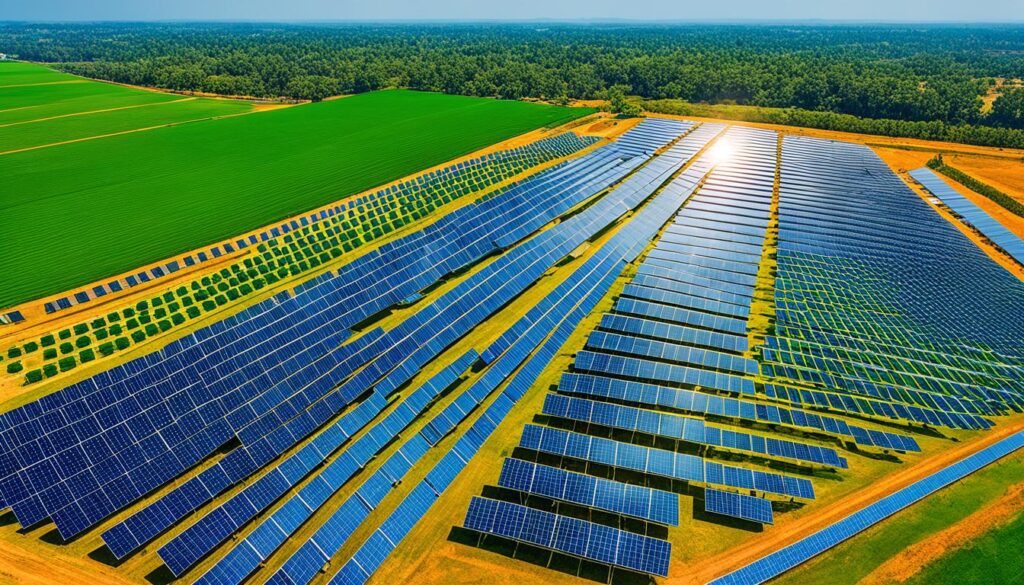India has emerged as a global leader in the field of solar energy, making significant strides in harnessing the power of the sun. With an installed solar power capacity of 73.32 GWAC as of December 2023, India has cemented its position as one of the world’s largest solar energy producers. The country has also attracted substantial capital investments of nearly $20.7 billion for solar power projects from 2010-2019, signifying the confidence and interest of investors in India’s solar energy sector.
As India ramps up its efforts to transition to clean and sustainable energy, the nation has set ambitious targets for the future. In the fiscal year 2023-2024, India aims to issue tenders for 40 GW of solar and hybrid projects, demonstrating its commitment to expanding its solar energy capacity. Furthermore, the establishment of 42 solar parks across the country, such as the Rewa Ultra Mega Solar Park and the Bhadla Solar Park, showcases India’s dedication to solar energy development.
The significance of solar energy extends beyond the generation of electricity. Solar power has had a transformative impact on the environment, economy, and employment. By harnessing the energy of the sun, India is reducing its carbon footprint and combatting climate change. Additionally, the solar industry has already created over 3 million jobs worldwide, contributing to economic growth and providing employment opportunities for individuals across various sectors.
Key Takeaways:
- Solar energy plays a crucial role in India’s efforts to transition to clean and sustainable energy sources.
- India’s installed solar power capacity of 73.32 GWAC highlights its position as a global leader in solar energy production.
- The country has attracted significant capital investments for solar power projects, indicating the confidence of investors in India’s solar energy sector.
- India aims to issue tenders for 40 GW of solar and hybrid projects in the fiscal year 2023-2024, showcasing its commitment to solar energy expansion.
- The establishment of solar parks across India demonstrates the nation’s dedication to solar energy development.
Technological Advancements in Solar Power
In recent years, there have been significant technological advancements in the field of solar power, leading to greater efficiency and enhanced capabilities of solar panels. These advancements have paved the way for a more sustainable and reliable source of energy.
Improved Solar Panel Efficiency
Solar panels have come a long way in terms of efficiency, with advanced models now achieving efficiency rates exceeding 23%. This means that more sunlight is converted into usable energy, maximizing the output of each panel. The increased efficiency translates into higher energy generation and better overall performance, making solar power an even more attractive option for homeowners and businesses alike.
Bifacial Solar Panels
One notable innovation in solar panel technology is the emergence of bifacial solar panels. These panels are designed to capture sunlight from both sides, harnessing not only direct sunlight but also reflected sunlight from the ground or nearby surfaces. Bifacial solar panels have the potential to increase energy yield by up to 25% compared to traditional panels, making them a compelling choice for solar installations where space is limited.

Solar Storage Solutions
Advancements in solar storage solutions have also played a crucial role in enhancing the efficiency and reliability of solar power systems. Solar storage solutions, such as batteries, allow for the accumulation and utilization of solar energy during periods of low sunlight, such as cloudy days or at night. This ensures a steady and consistent power supply, reducing reliance on the grid and increasing the potential for solar energy independence.
By incorporating solar storage solutions into solar power systems, individuals and businesses can maximize the use of solar energy, even when the sun is not shining brightly. This improves the overall resilience and viability of solar power as a sustainable energy source.
With the continuous advancements in solar panel efficiency, the emergence of bifacial panels, and the integration of solar storage solutions, the future of solar power looks bright. These technological advancements not only increase the overall effectiveness of solar energy systems but also contribute to a greener and more sustainable future.
Solar Power’s Impact on the Environment and Economy
Solar energy plays a crucial role in combatting climate change by harnessing the power of the sun to produce clean, renewable energy without emitting harmful greenhouse gases. This sustainable energy source has the potential to significantly reduce our carbon footprint and promote a more environmentally friendly future.
One of the most notable impacts of solar power is its ability to create jobs in the renewable energy sector. The solar industry has already generated over 3 million jobs worldwide, providing employment opportunities and contributing to economic development. As solar power continues to grow, so does the demand for skilled workers in installation, maintenance, and manufacturing.
Renewable energy jobs not only stimulate economic growth but also help to address social inequalities. Accessible and inclusive solar energy projects can uplift communities, especially those in rural areas, by providing reliable electricity, improving healthcare services, and enhancing education opportunities.
“Solar energy offers a unique opportunity to address climate change and create sustainable economic development hand in hand.” – Rajendra Kumar Pachauri
Solar Power Success Stories
There are numerous success stories that demonstrate the tangible benefits of solar power on both the environment and the economy. One notable example is the Bhadla Solar Park in India, which has become the largest solar park in the world. With a capacity of 2,245 MW, this solar project not only contributes to India’s renewable energy goals but also creates employment opportunities and supports local communities.
California, a global leader in renewable energy, has set a goal to transition to 100% clean energy by 2045. This ambitious target showcases the state’s commitment to combating climate change and reducing its reliance on fossil fuels. Solar power plays a crucial role in California’s clean energy transition, creating jobs, reducing carbon emissions, and paving the way for a sustainable future.
| Benefits of Solar Power | Impact |
|---|---|
| Reduces greenhouse gas emissions | Significantly reduces carbon footprint and mitigates climate change. |
| Creates renewable energy jobs | Contributes to economic growth and provides employment opportunities. |
| Empowers local communities | Improves access to electricity, healthcare, and education. |
| Facilitates a sustainable future | Promotes clean energy adoption and reduces reliance on fossil fuels. |
The Future of Solar Energy: Innovations and Challenges
The future of solar energy holds immense potential for innovation and overcoming existing challenges. One exciting development is the concept of floating solar farms, which utilize bodies of water for electricity generation. These floating solar farms not only allow for efficient use of space but also offer increased energy output due to the cooling effect of water.
Another innovation in solar power is the use of transparent solar cells. These cells have the ability to generate electricity while still allowing light to pass through, making them suitable for applications like windows or screens. With transparent solar cells, buildings and vehicles can effortlessly harvest solar energy without compromising aesthetics or functionality.
While the future of solar energy is bright, there are some challenges that need to be addressed. One such challenge is energy storage. The intermittent nature of solar power necessitates effective storage solutions to ensure a steady supply of electricity during periods of low solar irradiation. Researchers are working on improving battery technologies and exploring alternative storage options to enhance solar energy storage capabilities.
In addition, the environmental impact of solar panel manufacturing is another concern. Solar panels require the extraction and processing of raw materials, as well as energy-intensive manufacturing processes. Finding ways to minimize the environmental footprint of solar panel production is crucial for ensuring the long-term sustainability of solar energy.
Despite these challenges, the benefits of solar energy as a renewable and clean energy source cannot be overlooked. Solar power offers a way to reduce greenhouse gas emissions, combat climate change, and create a sustainable energy future. Continued research, innovation, and investment will play a vital role in addressing the drawbacks and maximizing the potential of solar energy as a leading sustainable energy solution.
FAQ
What is solar energy?
Solar energy is the energy derived from the sun’s radiation, which is harnessed through the use of solar panels or photovoltaic cells to generate electricity or heat.
How does solar energy work?
Solar energy works by converting sunlight into usable energy through the use of solar panels. These panels contain photovoltaic cells that absorb photons, releasing electrons and generating an electrical current.
What is the installed solar power capacity in India?
As of December 2023, India has an installed solar power capacity of 73.32 GWAC (gigawatt alternating current).
What are bifacial solar panels?
Bifacial solar panels are advanced panels that can harness sunlight from both sides. They are gaining popularity due to their ability to increase energy yield by up to 25% compared to traditional panels.
How does solar storage solutions work?
Solar storage solutions, such as batteries, enable the storage and utilization of solar energy during cloudy days or at night. They store the excess energy generated by solar panels for later use.
What is the environmental impact of solar panel manufacturing?
Solar panel manufacturing does have an environmental impact, primarily due to the extraction of raw materials and the energy-intensive production processes. However, the overall environmental benefits of solar energy outweigh the manufacturing drawbacks.
How does solar energy combat climate change?
Solar energy produces clean, renewable energy without emitting greenhouse gases. By reducing our reliance on fossil fuels, solar power plays a crucial role in mitigating climate change and reducing our carbon footprint.
How many jobs has the solar industry created worldwide?
The solar industry has already created over 3 million jobs worldwide, contributing to economic development and job opportunities in renewable energy sectors.
Can solar energy be integrated into other technologies?
Yes, solar energy can be integrated into other technologies. Innovations such as floating solar farms, transparent solar cells, and solar roads are expanding the possibilities of solar power integration.
What are some success stories in solar power?
Examples of solar power success stories include the Bhadla Solar Park in India and California’s commitment to transitioning to 100% clean energy by 2045, showcasing the tangible benefits of solar energy.

